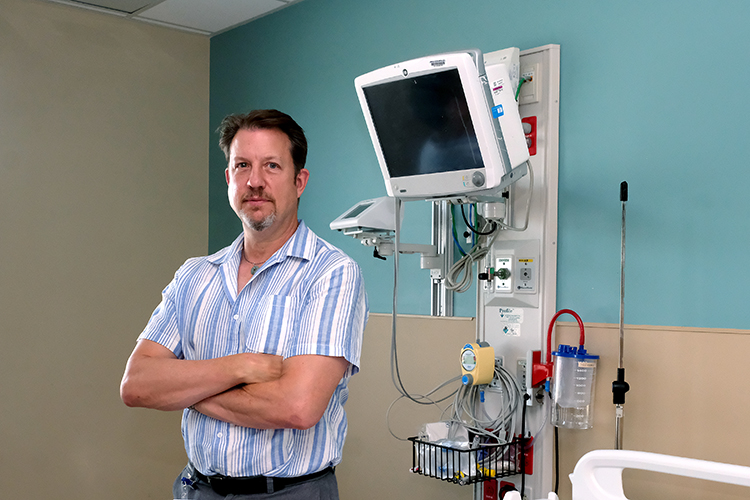When your child needs surgery it can be overwhelming and frightening. After all, children are not simply small adults, and they cannot always say what is bothering them. They can’t always answer medical questions and sometimes won’t even sit still for a medical exam.
Fortunately, pediatric surgeons are trained to operate on children from birth through late adolescence and they know how to examine and treat children in a way that makes them feel relaxed and safe. They have special equipment and facilities specifically designed for the needs of children and they are specially trained to treat the unique and sometimes rare illnesses that affect children.
Unfortunately, finding a pediatric surgeon is not always easy, as there just aren’t very many around.
“There are more NFL football players than pediatric surgeons,” Dr. Colin Knight, a pediatric surgeon with HCA Florida Lawnwood Hospital, said. “In communities that don’t have a pediatric surgeon, basic operations on children often are done by general surgeons.
“It takes about 29 years of education and training to become a pediatric surgeon,” said Dr. Knight. “That’s counting grades K-12, four years of college, four years of med school, five years of adult general surgery training, two additional years of fellowship training in pediatrics, and one to five years of research and clinical training. Most pediatric surgeons are in their early 30s before they complete their education and training and get certified by the American Board of Surgery in both General and Pediatric Surgery.”
Even though many child surgeries are done by general surgeons, certain cases require the advanced training and expertise of a pediatric surgeon because surgical problems seen by pediatric general surgeons are often quite different from those commonly seen by adult general surgeons.
A pediatric surgeon is a true generalist who has the skill and knowledge to operate on every part of a child’s body. They will operate on the chest, the neck, the belly, the back – literally wherever the problem is located. They also treat a variety of age groups which present their own set of challenges because the disease of a premature baby is different from the disease of a newborn, which is different, in turn, than those of a toddler or adolescent.
Pediatric surgeons also have unique instruments designed and scaled specifically for use in small patients as well as very specialized tools that are only used for certain pediatric operations.
Some of the more common surgeries performed by a pediatric surgeon are appendectomies; surgical repair of birth defects including esophagus, lungs, intestinal tract and abdomen wall defects; surgery for abnormalities of the groin in childhood and adolescence like undescended testes, hernias and hydroceles; removal of cancerous tumors; and trauma wounds.
“Our bread-and-butter surgeries are skin and soft tissue surgeries,” Dr. Knight continued.
“We get a lot of lumps and bumps. When a child has a skin lesion and the dermatologist needs a biopsy but the patient is too young to have it done in the office, they might be sent to us. A really common soft tissue operation in the United States is a circumcision. Umbilical and groin hernias are also very common.”
Fixing birth defects is another specialty of pediatric surgeons. Depending on what the anomaly is, a birth defect can be addressed immediately after delivery or it may be something that is monitored to see if it goes away naturally.
“If a child is born without an anus, we will operate immediately or within the first few days of life,” Dr. Knight explained. “But other congenital defects we might just watch and see if it goes away on its own. One example of a congenital defect that often resolves itself is a little girl born with an ovarian cyst. This usually happens because she is exposed to the high estrogen environment of her mother and after she is delivered that estrogen goes away and over the course of months that cyst might disappear on its own and never require an operation.”
There are pediatric surgeons in the country who will even do surgery within the uterus, but these operations generally are done in specialized children’s hospitals.
According to Dr. Knight, the three most common fetal surgery interventions are for myelomeningocele, which is an extreme form of spinal bifida; diaphragmatic hernia surgery to repair a hole in the child’s diaphragm, which pushes the intestines up into the chest and prevents the lungs from full developing; and a procedure for twin-twin transfusion syndrome that repairs abnormal blood vessel connections from the placenta to allow blood to flow evenly between twins.
These specialized prenatal surgeries are not performed at HCA Lawnwood Hospital, but Dr. Knight may be called in for a consult with the parents to provide them with knowledge ahead of time.
“Working with children and having the opportunity to improve their quality of life is very gratifying,” Dr. Knight proclaimed. “My patients have their whole life ahead of them and I want to make sure it’s the best it can be.”
After graduating from the University of Virginia and finishing a surgical internship, Dr. Knight served 4 years as a primary care doctor in the United States Air Force while serving in multiple deployments. He finished his pediatric training at the Children’s Hospital of Michigan in Detroit and went on to practice at Nicklaus Children’s Hospital in Miami Florida. He obtained his Surgery and Pediatric Surgery certifications in 2006 and 2008 respectively.
Although most of his patients are referred to him by their pediatricians or other pediatric specialists, he can be reached at his office at HCA Florida Lawnwood Hospital, 2402 Frist Blvd., Suite 204. Fort Pierce, 772-462-3939.

